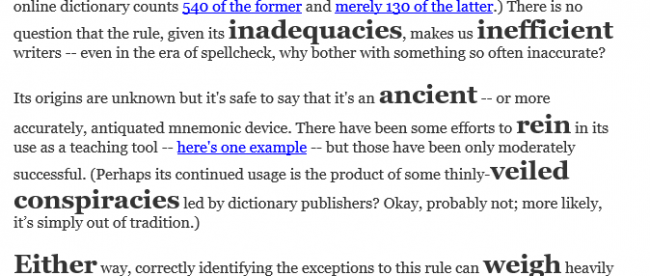I Before E, Except After C

Probably every English-speaking person in society once learned a simple law of spelling: “I before E, except after C.” It’s a key part of grammar school education; by third grade, you’ve almost certainly committed it to memory.
It’s not a very good rule, using it is more art than science. It’s dicier than most other rules for a simple reason — it’s very often just plain wrong to the point of being worthless.
The rule has a boggling high number of exceptions, rendering it basically useless. Some exceptions are weird; some others are fancier than you might expect. In total, there are literally thousands of exceptions to the rule – in fact, there are more occurrences of “cie” in the English language than the “proper” usage of “cei.” (One online dictionary counts 540 of the former and merely 130 of the latter.) There is no question that the rule, given its inadequacies, makes us inefficient writers — even in the era of spellcheck, why bother with something so often inaccurate?
Its origins are unknown but it’s safe to say that it’s an ancient — or more accurately, antiquated mnemonic device. There have been some efforts to rein in its use as a teaching tool — here’s one example — but those have been only moderately successful. (Perhaps its continued usage is the product of some thinly-veiled conspiracies led by dictionary publishers? Okay, probably not; more likely, it’s simply out of tradition.)
Either way, correctly identifying the exceptions to this rule can weigh heavily in the brains of those for whom spelling is critical — and as many writers (albeit not all of them) power through essays with caffeine as their fuel of choice, it’s probably not fair of us to teach the rule and tire them out even further. For those who are more proficient in the language and are better at avoiding these traps, sure, it’s much ado about nothing. But regardless, the rule is easy to violate. As proof, in the words above, the “I before E, except after C” rule has been violated eighteen times.
Make that nineteen.
Bonus fact: There is a town of about 1,400 people in Missouri named Pierce City — note the “ie.” It is named after a railroad pioneer named Andrew Peirce — “ei” — and was spelled Peirce City (again, “ei”) until the 1930s. Around then, the United States Census Bureau “corrected” the error, renaming the town Pierce City (“ie”) in its records. As reported by the UPI, an attempt to revert the name back to its original, correct spelling was waged by a former town mayor in 1982, but it failed when it was rebuffed — by the Census Bureau.
From the Archives: Tittle: The “i”s have it. (Click, and you’ll see.)
Related: “I Before E (Except After C): Old School Ways to Remember Stuff” by Judy Parkinson. 4.5 stars on 16 reviews. Available on Kindle.

Leave a comment